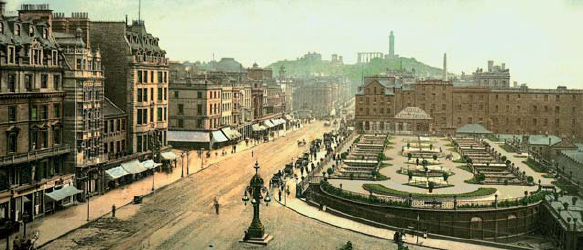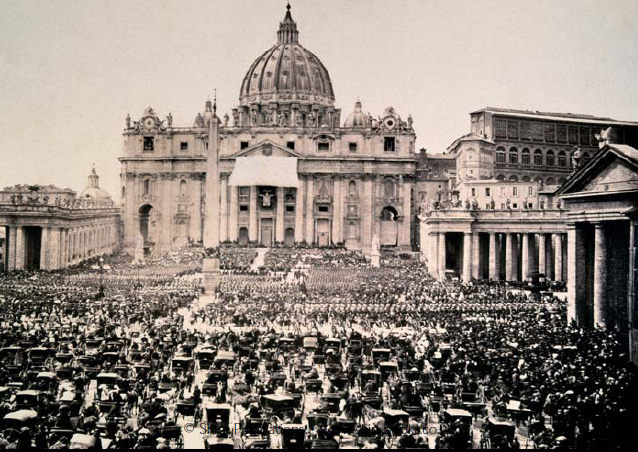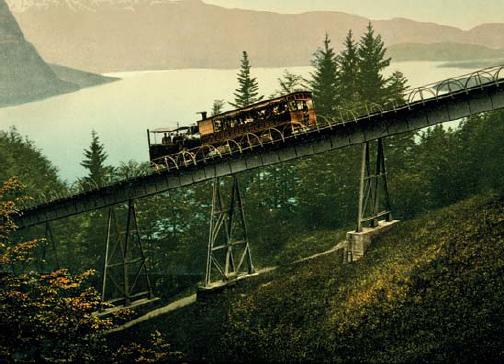

Princes Street, Edinburgh in 1896, with Thomas Cook’s Travel Office at the end of the gardens.

Visitors to Rome in the 1870s could buy an extensive range of photographic mementoes of their experience. This view of St Peter’s Square was taken during an Easter Sunday Mass, c.1875.
The Victorian Grand Tours of Europe and of the Middle East were as much about advertising your status as they were about the experience of travel. As travel became easier, and the middle classes became more affluent, travel to mainland Europe, and later farther afield, became increasingly popular. As the numbers increased, so did the availability of every tourist need – accommodation, guides, interpreters, guidebooks and photographic mementoes. Thomas Cook organised his first trips to France in the early 1850s, and by the end of the decade his catalogue of tours offered the opportunity to travel much further afield.
In the 1850s and 1860s, travelling conditions were pretty primitive – ships were small, so the channel crossing to France was often difficult, and journeys to the Mediterranean through the Bay of Biscay could be really unpleasant. But still they went!
The diaries of four Cheshire travellers, the Garnetts and the Marsdens, recall two ‘tours’ in the 1880s and 1890s. While Mrs Garnett wrote a daily diary, and Mr Garnett sketched wherever they travelled, the Marsdens collected together a photographic account of their experiences.
There was the constant fear of any number of diseases – which Mrs Garnett felt could be caught just by walking down any foreign street – and finally there was the great unforgivable characteristic of the ‘natives’ wherever they went: they were all foreign, and unable in most cases to understand even the basic rudiments of English! Settled into a high-class hotel where English was spoken, and pens and writing paper were freely available for the guests, Mrs Garnett wrote in her diary of a Nile trip with several overnight stopovers, ‘We have been such vagabonds upon the face of the earth, sleeping in such a variety of hotels (and such wretched berths on the Chuzan), and having been addressed in so many different languages, that now we really seem to have found a resting place and a home.’

At the Rigi Mountain Railway in Switzerland, a popular visitor location since the 1860s, visitors throughout the Victorian and Edwardian era could select from a catalogue of regularly updated images. This coloured ‘Photochrome’ view dates from c.1896.

The ascent of the Pyramid of Cheops, Giza, Egypt, photographed by the Zangaki Brothers in the 1870s. An eloquent and highly informative take on the challenges of undertaking the Middle Eastern Grand Tour.
The beauties of the Nile were undeniable, and apparent even to first-time travellers – the little booklets which Thomas Cook’s tourists took with them not only told them so, but also told them how to respond to what they saw – and the ruined temples and carvings impressed the two families from Warrington. What made the greatest mark on them all, however, was their visit to Giza and the ascent of the Great Pyramid of Cheops.
The view from the top of the great pyramid was the high spot – quite literally – of the tour, but getting there was the most fraught part of the whole journey. Mary Garnett’s diary recounts all her fears and misgivings about the whole project: ‘A visit to the Pyramids means a hand-to-hand fight with dragomans, rightly named. I had twelve to myself, who badgered me to buy scarabs which I knew had been made in Birmingham, and to haul me up the stony structure against my will and finally haul me into the interior... for once in their clutches you would not leave those dark and dreadful recesses while a single coin remained in your pocket.’ Remember, this is a holiday she is writing about!
Later in her diaries, recounting the second trip (one wonders why she went back if she disliked it so much), Mary Garnett describes ‘Lily M’s’ first encounter with the Pyramid and the ever-present dragoman. ‘We drove to the Pyramids of Gizeh yesterday, and Lily and Mr H. M. were lugged up. Had about four Arabs each. I watched the operation through my glass, and when some distance from the top, perceived that Lily’s party stopped and all the Arabs crowded down. I feared she had fainted. The heat was intense and she had gone off in a faint at the tombs of Beni Hassan after a great climb… At last they rose and went forward… When she came down, she told me she had sat down to rest, and had been showing those men the photographs of all her friends and Sunday School scholars, which she was carrying to the top! She is not the least afraid of the men, and even poor I, yesterday, did not suffer as I did last time, for I made them know I had been last year and knew all about it.’
The picture of the ascent of the pyramid is an eloquent statement about the social and personal challenges that went with the experience. There are, of course, more servants than travellers and in that respect, the relationships are as one might expect. But there is much more to the picture. At the base of the pyramid, all is normal. The travellers are seated on camels; the servants are on foot. The male travellers are engaging with the camera, not with the servants; the female travellers are looking out of shot, not relating to anything that was going on except, perhaps, their ever-present fear of the dragoman, the Arab. As soon as the ascent of the pyramid commences, however, relying on the Egyptian guides became essential. Ascent of the huge stone blocks in what passed for holiday attire could not easily be achieved without strong Arab arms to haul the visitors up. And for British ladies to hold hands with the Arabs they so feared... well, some things just had to be endured!